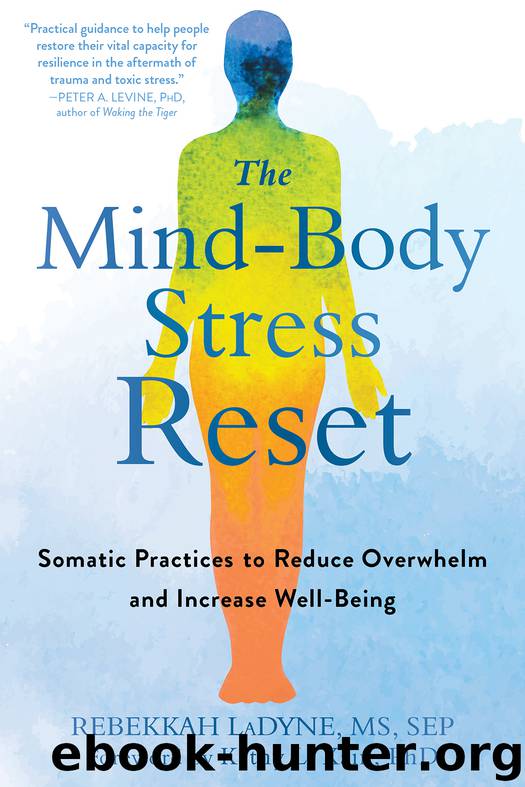The Mind-Body Stress Reset by Rebekkah LaDyne

Author:Rebekkah LaDyne
Language: eng
Format: epub
Tags: Stress;anxiety;overwhelm;trauma;worry;fear;panic attacks;dysregulation;nervous system regulation;self-regulation;mind-body connection;mind-body wellness;mind-body medicine;somatic therapy;somatic experiencing;SE;Mental Health;Mental and Spiritual Healing;Counseling;Somatic Therapy;Health and Fitness;PTSD;complex PTSD;Personal transformation;Wellness
Publisher: New Harbinger Publications
Published: 2020-02-18T22:20:13+00:00
I sometimes catch myself:a. Panting b. Holding my breath c. Neither
I feel like I can’t take a full and deep breath:a. Often b. Sometimes c. Never
When I’m stressed I feel light-headed or dizzy:a. Often b. Sometimes c. Never
When I’m stressed I can feel my belly or chest tighten making it hard to breathe
a. Often b. Sometimes c. Never
Take note of how many of your answers are “a”s. Four or five “a”s indicates your breathing and stress are fairly linked; four or five “b”s indicates your breathing and stress are moderately linked; four or five “c”s indicates your breathing and stress are not very linked. A combination—say, two or three each “a”s and “b”s, “a”s and “c”s, or “b”s and “c”s—indicates that sometimes your breath is part of your stress reaction, sometimes not.
This is not a static result; it may—and is likely to—change over time. Your awareness of your breathing may also change. Because of both of these factors, you might want to answer these questions again in a month or two after you’ve increased your awareness of your breathing overall.
No judgment needed: it is not better to have “a”s or better to have “c”s. This is just your body talking to you, letting you know whether the breath is one of its primary stress expressions or not.
For Susan, the woman I described at the start of this chapter, her struggle with gasping and shortness of breath was a substantial contributor to her stress. Not getting enough air played a big role in her stress reaction, and the experience of full breaths was a significant aid to her stress resilience. For others it is subtler—like for Max, who used slow and low and rescue breaths as a reassuring background support throughout his stress recovery. And sometimes, breathing starts in the background and then moves very surely to the forefront. For my client Viola, her breathing helped little by little over time and then one day was profoundly impactful.
Over decades, Viola’s emotional overwhelm and pain had become lodged in her body, becoming physical overwhelm and pain. She had been struggling with a few autoimmune diseases and was so tired of feeling so tired all the time. The breath became an important ally for Viola.
First, she adopted a regular awareness practice that included slow and low breathing. Reclining in the comfort of her home, she would take time to breathe and be. This created a positive imprint and a new pathway of regulated breathing that I saw her use many times in our work together.
As a result of Viola’s regular breathing practice, whenever I asked her to sense her body during our sessions together, a few deep breaths accompanied the process. One day, as she sensed into her body with the sensations of the breath there as a trusted companion to her process, she described feeling a lightening that hadn’t been there for a long time. With the help of her easy breathing, she stayed with her sensations to witness them change and morph from her familiar fatigue to an uprightness and strength she hadn’t felt in a while.
Download
This site does not store any files on its server. We only index and link to content provided by other sites. Please contact the content providers to delete copyright contents if any and email us, we'll remove relevant links or contents immediately.
Should I Stay or Should I Go? by Ramani Durvasula(7560)
Why We Sleep: Unlocking the Power of Sleep and Dreams by Matthew Walker(6618)
Fear by Osho(4655)
Flow by Mihaly Csikszentmihalyi(4634)
Rising Strong by Brene Brown(4377)
Why We Sleep by Matthew Walker(4358)
The Hacking of the American Mind by Robert H. Lustig(4318)
How to Change Your Mind by Michael Pollan(4288)
Too Much and Not the Mood by Durga Chew-Bose(4270)
Lost Connections by Johann Hari(4088)
He's Just Not That Into You by Greg Behrendt & Liz Tuccillo(3830)
Evolve Your Brain by Joe Dispenza(3610)
The Courage to Be Disliked by Ichiro Kishimi & Fumitake Koga(3407)
Crazy Is My Superpower by A.J. Mendez Brooks(3328)
In Cold Blood by Truman Capote(3304)
Resisting Happiness by Matthew Kelly(3300)
What If This Were Enough? by Heather Havrilesky(3270)
The Book of Human Emotions by Tiffany Watt Smith(3237)
Descartes' Error by Antonio Damasio(3229)
